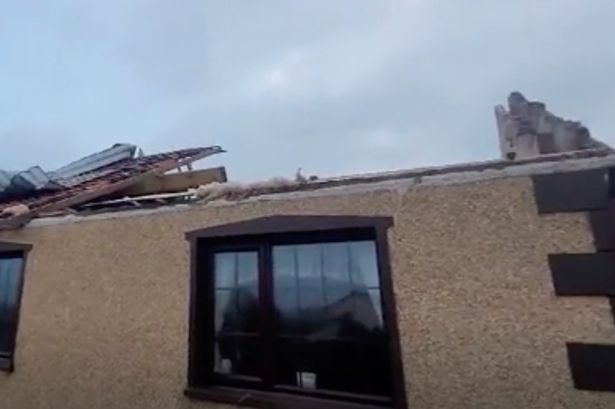The devastating impact of Storm Éowyn, which triggered a red weather warning across Northern Ireland, has left Tracy McMahon and her husband, Tam, facing the stark reality of homelessness. Their home, unable to withstand the storm’s brutal force, suffered catastrophic damage, rendering it uninhabitable. This sudden and unexpected loss has plunged the McMahons into a precarious situation, forcing them to grapple with the immediate challenges of securing temporary shelter, salvaging what possessions they can, and navigating the complex process of rebuilding their lives. Their story underscores the vulnerability of individuals and communities in the face of increasingly extreme weather events, highlighting the urgent need for robust infrastructure, effective disaster preparedness strategies, and comprehensive support systems for those affected.
The McMahons’ experience serves as a microcosm of the wider disruption caused by Storm Éowyn. The red weather warning, the highest level of alert issued by meteorological authorities, signaled the potential for severe and widespread damage. High winds, torrential rain, and potential flooding posed significant threats to homes, businesses, and critical infrastructure. Across Northern Ireland, communities braced themselves for the impending onslaught, taking precautions to mitigate potential harm. However, for some, like the McMahons, the storm’s fury proved too overwhelming, leaving a trail of destruction and displacement in its wake. The storm served as a stark reminder of the unpredictable and powerful forces of nature and the vulnerability of human-built structures in their path.
The McMahons now face the daunting task of piecing their lives back together. The immediate priority is securing safe and stable temporary accommodation while they assess the extent of the damage to their home. This involves contacting insurance providers, documenting the destruction, and working with assessors to determine the feasibility of repairs or the need for complete reconstruction. The emotional toll of losing their home, coupled with the logistical complexities of navigating the recovery process, presents a significant burden. The uncertainty surrounding their future living arrangements, the potential financial implications, and the disruption to their daily routines add layers of stress and anxiety to an already challenging situation.
Beyond the immediate practicalities, the McMahons must also contend with the emotional fallout of this traumatic event. The loss of their home represents the loss of a sanctuary, a place of comfort and security. The displacement from familiar surroundings, the disruption of established routines, and the uncertainty of the future can lead to feelings of vulnerability, anxiety, and grief. The process of rebuilding, both physically and emotionally, will require resilience, support from their community, and access to resources that can help them navigate the challenges ahead. The road to recovery will undoubtedly be long and arduous, demanding both inner strength and external assistance.
The plight of the McMahons highlights the broader societal implications of extreme weather events. As climate change intensifies, the frequency and severity of such storms are predicted to increase, posing significant risks to communities worldwide. This underscores the urgent need for proactive measures to mitigate these risks, including investing in resilient infrastructure, developing comprehensive disaster preparedness plans, and strengthening support systems for those affected by extreme weather. Furthermore, it emphasizes the importance of raising public awareness about the realities of climate change and the need for collective action to address this global challenge. The McMahons’ story serves as a powerful reminder that the impacts of climate change are not abstract or distant but are already affecting real people’s lives in tangible and devastating ways.
The response to the McMahons’ situation will be a testament to the strength and compassion of the community and the effectiveness of existing support systems. Local authorities, charities, and community organizations play a crucial role in providing immediate assistance to those displaced by the storm, including emergency shelter, food, clothing, and emotional support. The long-term recovery process will require a coordinated effort from various stakeholders to ensure that affected families receive the necessary resources to rebuild their homes and their lives. The McMahons’ story underscores the interconnectedness of communities and the importance of collective action in times of crisis. It serves as a call for greater resilience, preparedness, and support in the face of increasing climate-related challenges. The hope is that through the collective efforts of the community, government agencies, and support organizations, the McMahons and others affected by Storm Éowyn can begin the arduous journey of rebuilding their lives and finding a path toward a more secure and stable future.














